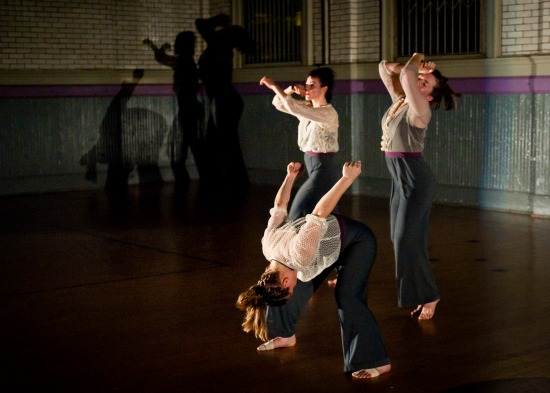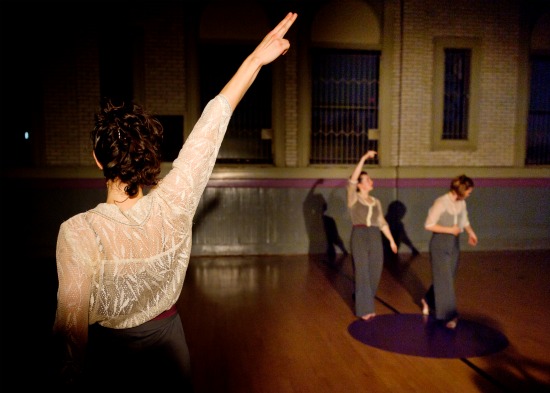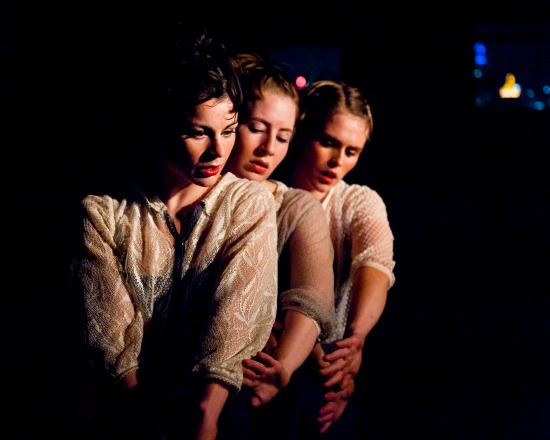
Ariel Pierce (foreground), Aiofe McAtamney (left), and Anneke Hansen in Hansen's younandyouandyou. Photo: Ian Douglas
Just when you’re blinking into 2012, The Association of Performing Arts Presenters (APAP) schedules a conference in New York, and zillion of companies showcase their work. This year, from January 5 to 9 and beyond, every dance venue in the city hosts performances ranging from whole dances to excerpts. The hoped-for audiences? That would be the presenters. But friends, fans, critics, and the curious appear at the showings, many of which are free. You bump into someone who tells you of one performance you didn’t know about, and you have to figure out whether you can fit it between two others you did know about and maybe have lunch too.
The gifted young choreographer Anneke Hansen has already shown her youandyouandyou at University Settlement at 11 A.M. on Saturday January 7, but when I arrive for the 1:30 P.M. show, there’s still cider and cookies and some very good little pinwheels that taste like pizza. Very gracious of her and her associates (and smart).
The “you”s of the title are three women—Hansen, Ariel Pierce, and Aiofe McAtamney—and they’re performing in the building’s ancient gymnasium on the 6th floor, with high-up windows looking out on Eldridge and Rivington Streets. We begin by climbing the narrow staircase to the balcony above and looking down at the space and Pierce dancing in the middle of it. She’s worth watching—sinuous, gutsy, fierce at times. She makes us really see the space by directing her own focus around it, while composer Nathan Koci strikes a few spare chords on his accordion. Hansen and McAtamney invade the territory slowly. Close together, spoon-fashion, they take soft, careful steps backward along one wall, each pressing a hand to it and following every change in its contours.
Then we descend the stairs to sit on chairs placed on the room’s long side. Hansen, the director of Anneke Hansen Dance, has worked with Sara Rudner, Susan Rethorst, and Australia-based choreographer Russell Dumas; she assists dance’s great anatomist Irene Dowd. If any of those names means something to you, you might be able to envision how Hansen moves and how she thinks about dancing. This is beautiful, sensual, thoughtful work—neither dreamy nor indulgent and full of surprises. Hansen herself warms the room; her nuanced movements animate the space around her; her feet— treading as sinuously as a cat’s—make the hardwood floor seem plushy.
The three women move sensitively together, despite their individual qualities. Pierce, like Hansen, worked with Rudner at Sarah Lawrence, and is only slightly tauter than Hansen, while Irish, ballet-trained McAtamney is more introverted—a bit less at ease than the other two. I like watching all three. And am happy to notice that the fluid, slate-blue pants that Deborah Black designed for the dancers match the lower portion of the gymnasium walls. The lacy jackets they wear are the cream-color of the upper part, and their purple waistbands match the line of paint that separates the two halves.
Sometimes the women investigate the same movement material, but in different ways or at different times, so it always comes as a surprise when two of them, or all three, slip into momentary unison. Your eyes get used to darting. There are bursts of speed and pockets of quiet. Hansen and McAtamney keep still and watch while Pierce experiments with balancing on the ball of one foot for a long time. They lie on the floor, supine, and twitch to make themselves jolt along, but get nowhere. They make their hands mimic a beating heart. Sometimes they stagger or fall, but it’s all part of this day’s work. They dance using the wall as a support. Interestingly, they touch only occasionally, but their intimacy is palpable.
At one point, the women’s shadows darken a wall. Late in the piece, the sun sneaks narrow beams along the floor. Koci’s music, honors youandyouandyou’s moments of stillness with silence, and his spare punctuation suits the dynamics of the choreography. Here, he drops in an unexpected discordance, there a bit of melody, now he stirs up turbulence. When he plays a jaunty tune on the accordion, the dancers decide to play with slowness for a while before matching its springiness. Sometimes a sound or two affirms what they do, as if Koci wanted to say, “Aha! Look at that!”
Hansen has crafted youandyouandyou elegantly—recycling motifs and showing you how different yet how alike they can be. Everything in the piece seems organic, but not in a single-minded way. It’s rife with serene complexity.
Walking back down the hall afterward, I see that the cookies are gone. No problem. I’m all filled up.



In Deborah’s eloquent description, this piece looks like choreography about the friendship of women who have known each other long and well, who accommodate and celebrate their differences in temperament, style, history even. Sisterhood, in fact, in fact, without the politics. I wish I had seen this piece, and many others presented at APAP.
Fabulous, what a webpage it is! This webpage presents valuable data to us, keep it up.
“…And am happy to notice that the fluid, slate-blue pants that Deborah Black designed for the dancers match the lower portion of the gymnasium walls…” (Deborah J) – Me too, a refreshing concept. It is so enjoyable to read your blog Deborah, please keep writing – ” Happy to notice how your words travel.. fluid… into stories.” 😉
– Michelle